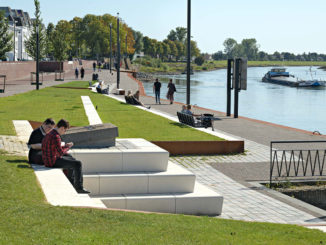Recently, WLA published 2020 Landscape Architecture Firm Internships which included a list of firms currently looking for interns for summer or fall of 2020.
This is a brief guide for submitting your application for a landscape architecture internship.
Do your research
The first thing you should do when looking for an internship is to undertake some research about the firms including where they are located, how big is the firm, do they specialise in one typology (public realm, private gardens). This will give you some background and assist you in writing your application.
Know the requirements
Make sure that you meet the internship requirements as the firms will have set these requirements (visa, residency, location, still studying or graduate) based on their past experience and their needs. If you do not meet the requirements then it may be best to apply elsewhere.
When and how long?
Make sure to find out when the internship starts and finishes and the hours (full time/part-time). These are good to know as they might clash with your term dates or other personal plans. The duration is also key as it may be short, which might not be suitable for you to move across the country for a short internship.
Prepare your resume or CV
You need to prepare your resume or CV (find out the difference here) with an easy to read layout and your contact details. Make sure you include skills, interests, education, any working experience and any relevant information.
Stay away from buzz words, skill tags, spend time creating a tailored CV or resume.
Create a Portfolio
Your portfolio gives you the opportunity to showcase your skills, design aesthetic and process. The key term is process. Many portfolios include several finished projects with beautiful renders, diagrams and axonometric thumbnails, but many forget to show the design process. As designers we are always interested in the process and how did you get to the final design? what was the process? what analysis did you undertake? how did you get to the design narrative? what influences(cultural, environmental, etc) impacted on the design?
When putting together a project remember to include a short blurb including what is the type of project? what year were you in? what did you learn from the project? and any other relevant information. Remember to keep it concise.
It is important to include various pieces and types of work to ensure that you show your depth of skill and learning. Go beyond the perspective renders and include sketches, hand drawings, technical drawings and anything else that you undertook during your studies.
Curate your Portfolio
As a student, you will have a limited number of projects to draw on but the key is to include your strongest work at the beginning. Then curate the work to the type of firm. When you apply to a residential landscape architecture firm then place any relevant residential design work at the start or if the firm concentrates on master planning include large scale design.
Tailor your a cover letter/email
Your application needs to stand out from the numerous submissions that they will receive. Go beyond the standard letter template with an introduction, middle and contact details. Make sure to discuss your passion, why you would like to work for the firm, whether you have visited any of their projects, what skills you have, and what you could bring to the internship. Remember to keep it to one page (three paragraphs for email).
Be Creative
Being creative with your portfolio or submission such as a short video or a portfolio in different graphic style (cartoon or freehand or watercolour) can make a difference, just keep in mind the audience and firm you are applying to.
Prepare for your interview
Design firms will likely want to have an interview with you whether in person or via video conference (facetime, skype, etc). Therefore you need to prepare by going over your research (about the firm), reread your resume and practice presenting your portfolio (key points, your role, design process, and what did you learn) prior to the interview. During the interview remember to relax, be yourself and breath.
Tip on what not to do and what to do
What Not to do
- (Don’t) Bulk email (bcc) every firm with the same template email letter – e.g Dear Sir/Madam. Take the time to tailor your email (see above) for your audience.
- (Don’t) Include a link to a portfolio (unless expressly requested) as firms do not have the time to wait for websites or document platforms to load and then review. They will most likely prefer a pdf.
- (Don’t) Regularly Call or Email the firm to ask about your application progress – many firms are busy and may take time to get back to applicants. Regular calls or emails add admin time that they do not have.
What to Do
- Write with passion
- Have a professional email address (e.g. johncitizenlandarch@gmail.com)
- Email a small-sized portfolio (screen resolution) under 10Mb
- Follow the requirements for the submission (is it to be emailed or submitted through a website or portal)
- Get someone to proofread and hear your presentation to pick up any mistakes or issues.
- Do not give up
The process can be hard but don’t be disheartened everyone has to start their career somewhere and it can be through an internship or through a graduate position later.
With internships, you get out of it what you put in, so remember that if you are able to get an internship that it is a two-way learning opportunity which allows you to learn about landscape architecture practice and provides the firm with an opportunity the firm to learn about you and what landscape architecture programs are teaching. Enjoy the experience and feel free to let us know about your experiences as an intern.

Article Written by Damian Holmes is the Founder and Editor of WLA.
Learn more about the Student categories for the 2020 WLA Awards
Cover Image: Flickr University of Wolverhampton – Attribution 2.0 Generic (CC BY 2.0)
DISCLAIMER: This article is for educational purposes only. The content is intended only to provide a summary and general overview on matters of interest. It’s not intended to be comprehensive, nor to constitute advice. You should always obtain professional or legal advice, appropriate to your own circumstances, before acting or relying on any of the above content.



